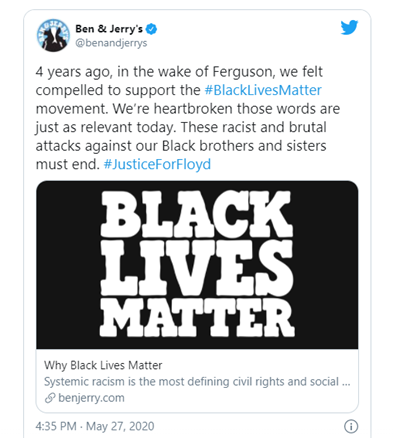
12 Jan Brand Activism on Social Media: How to Approach Social Justice Messaging in 2021
Diversity. Inclusion. Equality. Unconscious bias. Equity. The spring of 2020 challenged marketers to publicly identify where their brands stood on these words and the issue of social justice. 2020’s social unrest made it abundantly clear that consumers want to know, or rather demand to know, that the brands they support share their values and beliefs.

I’ve been around long enough to have seen the ebb and flow of activism. I’ve seen the “viral” impacts of consumers fighting for issues they strongly believe in or fighting against issues they believe demean the spirit of American democracy. But there was something different about what happened in June of 2020. Consumers are requiring more of the brands they support, particularly when they have a plethora of options for where to spend their money.
Nearly 20 years ago the management of corporate social responsibility was mostly placed within HR, diversity teams, or community relations teams. Occasionally marketing departments would create multiple versions of the same ad (white family, black family: check). However, 2020’s social justice crusades catapulted these responsibilities in a much broader way. Now marketing teams have joined HR, community relations, and diversity teams in the responsibility of reacting to and communicating a brand’s position on this very touchy subject. Some brands were well prepared and jumped into the fray, while others struggled to define their brand’s stance as events unfolded. Unlike many current event issues, what happened in 2020 forever changed how we market our brands and communicate their position within our everyday mix of marketing messages.
So, is your brand prepared? How will your team answer the call when the next big “event” occurs?
Here’s are some thoughts on how you might ensure your brand’s social media channels are prepared:
1. Throw Out Any “One and Done” Behaviors
Consumers will spend their precious dollars with brands that share their beliefs and values (especially Gen Z, which grows more and more buying power as they age up). If you jumped on the social justice bandwagon last year by turning your profile image black for a day or adding a #BLM to one Tweet, you have missed the mark and need to go back to the drawing board.

2. Be an Expert at “Reading the Room”
(Note: as I’m writing this post, there is chaos at the nation’s Capitol building.) In times of crisis, smart brands go “dark” and do not post until it is appropriate to do so. The not-so-smart brands continue to post and urge consumers to buy their projects or engage in what may feel frivolous while the rest of the world is focused on what really matters. The posts are at times comical, but mostly unfortunate. When your customers tell you to stop talking, you clearly have a problem with understanding your brand’s place in the world.
3. Have a Plan
While the best-laid plans can sometimes miss the mark, most often they will put you in a better position than having no plan at all. The key is creating a plan that is flexible yet cohesive. As you create your plan consider our 5 steps for evaluating your response:
- Pause everything
- Consider your audience
- Remember your brand voice
- Evaluate existing materials
- Create a backup plan
4. Don’t Dawdle
Be decisive with your responses, if they’re necessary. Waiting 3 or 4 days to speak out against social injustice could make your brand appear as though it’s following the crowd rather than leading the pack. Don’t hesitate to call an emergency meeting of the minds among your executive team to ensure everyone is on the same page and in agreement on what and when to post.
5. Be Authentic
As I mentioned earlier, do not subscribe to the “one and done” mentality. Consumers can smell inauthenticity a mile away. Ensure your brand’s position and message are clear and consistent when it comes to diversity, equity, and inclusion.

In the next couple of weeks, we will recognize the birth of civil rights icon, Dr. Martin Luther King Jr., and the month of February is Black History Month. It’s likely many brands will post something in recognition of these events. However, only those brands that think outside of milestone calendar events will be the most authentic and true in the minds of consumers. Ask yourself: would your brand speak out about the stark difference in treatment of looters at a convenience store vs that of insurgents who stormed the nation’s Capitol? Here’s a post our team did about Tweeting on MLK Day that you may find beneficial (it’s over 5 years old, but still very relevant today).
Communicating a brand’s stance and messaging around the issue of social justice should never be about using buzz words (the latest being brandstanding) or jumping on bandwagons. As marketers, our job is to represent our brand’s promise, beliefs, and values in a positive and thoughtful manner to our target audiences. The conversation must come full circle, we cannot talk about being a great workplace or community leader and ignore issues surrounding social justice and their impact on our employees and community.
As events continue to unfold and change over the coming days, weeks, and months, keep yourself up-to-date on best practices regarding social media marketing by subscribing to our bi-weekly newsletter below.
Subscribe to Social You Should Know






